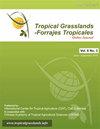Herbage yield and quality of Megathyrsus cultivars in Northeast Thailand
IF 0.7
4区 农林科学
Q3 AGRICULTURE, DAIRY & ANIMAL SCIENCE
引用次数: 3
Abstract
A field trial in Northeast Thailand during 2015‒2018 evaluated the forage accumulation and nutritive value of 5 Megathyrsus cultivars, Mombasa, Tanzania, Massai, Zuri and Mun River. Mombasa and Tanzania are commonly grown in Thailand, but Massai, Zuri and Mun River had not been evaluated in Thailand before. Overall accumulated DM yields for the various cultivars over the 3 years were 24,550 kg/ha for Tanzania, 30,900 kg/ha for Massai, 32,700 kg/ha for Mombasa, 35,600 kg/ha for Mun River and 35,700 kg/ha for Zuri. Over 3 wet seasons, Mun River and Zuri accumulated 49% more total DM and Mombasa 35% more total DM than Tanzania. Massai accumulated lower total DM yields than Zuri and Mun River in the second and third wet seasons, similar yields to Mombasa, and higher yields than Tanzania in those 2 seasons. Crude protein concentrations in forage were higher in the dry season than in the wet season and in leaves than in stems. There were no consistent differences in CP% of the various cultivars in wet or dry seasons. ADF and NDF concentrations in the dry season were lower than those in the wet season and leaf ADF and NDF concentrations were lower than concentrations in stems. There were no consistent differences of ADF and NDF concentrations between cultivars throughout the study. This trial showed that both Zuri and Mun River would be ideal replacements for Mombasa and Tanzania in Northeast Thailand, as they would appeal to smallholder farmers for cut-and-carry forage with their upright, broad leaves, and at least similar DM production to Mombasa and superior DM production to Tanzania.泰国东北部大樱草品种的牧草产量和品质
2015-2018年,在泰国东北部进行了一项田间试验,评估了5个巨型猪品种、蒙巴萨、坦桑尼亚、马塞、祖里和门河的饲料积累和营养价值。蒙巴萨和坦桑尼亚在泰国普遍种植,但马塞、祖里和门河在泰国之前没有被评估过。3年来,不同品种的DM累计产量坦桑尼亚为24550公斤/公顷,马赛为30900公斤/公顷,蒙巴萨为32700公斤/公顷,蒙河为35600公斤/公顷,祖里为35700公斤/公顷。在3个丰水季中,蒙河和祖里的总DM比坦桑尼亚多49%,蒙巴萨的总DM比坦桑尼亚多35%。在第二和第三丰水季,马塞的DM总产量低于祖里和门河,与蒙巴萨相似,但高于坦桑尼亚。干季牧草粗蛋白质含量高于湿季,叶中粗蛋白质含量高于茎中粗蛋白质含量。不同品种的CP%在湿季和旱季没有一致的差异。旱季ADF和NDF浓度低于雨季,叶片ADF和NDF浓度低于茎部。在整个研究过程中,不同品种间ADF和NDF的浓度差异不一致。该试验表明,Zuri和Mun River都是泰国东北部蒙巴萨和坦桑尼亚的理想替代品,因为它们具有直立、宽阔的叶子,对小农具有吸引力,因为它们可以收割和运输饲料,至少与蒙巴萨的DM产量相似,而与坦桑尼亚的DM产量更高。
本文章由计算机程序翻译,如有差异,请以英文原文为准。
求助全文
约1分钟内获得全文
求助全文
来源期刊

Tropical Grasslands-Forrajes Tropicales
Agricultural and Biological Sciences-Agronomy and Crop Science
CiteScore
1.60
自引率
0.00%
发文量
36
审稿时长
16 weeks
期刊介绍:
The Journal publishes, in English or Spanish, Research Papers and Short Communications on research and development, as well as contributions from practitioners (Farmer Contributions) and Review Articles, related to pastures and forages in the tropics and subtropics. There is no regional focus; the information published should be of interest to a wide readership, encomprising researchers, academics, students, technicians, development workers and farmers.
In general, the focus of the Journal is more on sown (''improved'') pastures and forages than on rangeland-specific aspects of natural grasslands, but exceptions are possible (e.g. when a submission is relevant for a particularly broad readership in the pasture and forage science community).
The Journal will also consider the occasional publication of associated, but closely related, research in the form of an additional scientific communication platform [e.g. a re-make of the former Genetic Resources Communication series of the former Division of Tropical Crops and Pastures of the Commonwealth Scientific and Industrial Research Organisation (CSIRO), Australia].
Areas of particular interest to the Journal are:
Forage Genetic Resources and Livestock Production[...]
Environmental Functions of Forages[...]
Socio-economic Aspects[...]
Topics within the aforementioned areas may include: Diversity evaluation; Agronomy; Establishment (including fertilization); Management and utilization; Animal production; Nutritive value; Biotic stresses (pests and diseases, weeds); Abiotic stresses (soil fertility, water, temperature); Genetics and breeding; Biogeography and germplasm collections; Seed production; Ecology; Physiology; Rhizobiology (including BNF, BNI, mycorrhizae); Forage conservation; Economics; Multilocational experimentation; Modelling.
 求助内容:
求助内容: 应助结果提醒方式:
应助结果提醒方式:


